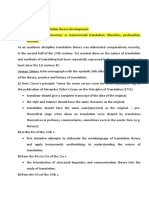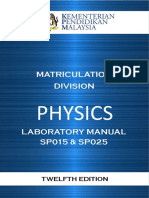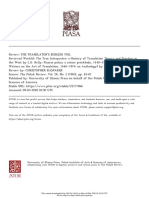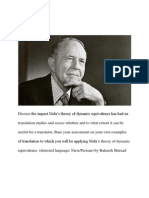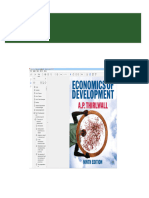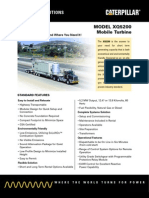0 ratings0% found this document useful (0 votes)
26 viewsSystematic Translation Theory
Systematic Translation Theory
Uploaded by
Yashra ShariqaThis presentation relies on systematic Translation theory
Copyright:
© All Rights Reserved
Available Formats
Download as PDF, TXT or read online from Scribd
Systematic Translation Theory
Systematic Translation Theory
Uploaded by
Yashra Shariqa0 ratings0% found this document useful (0 votes)
26 views15 pagesThis presentation relies on systematic Translation theory
Original Title
Systematic translation theory
Copyright
© © All Rights Reserved
Available Formats
PDF, TXT or read online from Scribd
Share this document
Did you find this document useful?
Is this content inappropriate?
This presentation relies on systematic Translation theory
Copyright:
© All Rights Reserved
Available Formats
Download as PDF, TXT or read online from Scribd
Download as pdf or txt
0 ratings0% found this document useful (0 votes)
26 views15 pagesSystematic Translation Theory
Systematic Translation Theory
Uploaded by
Yashra ShariqaThis presentation relies on systematic Translation theory
Copyright:
© All Rights Reserved
Available Formats
Download as PDF, TXT or read online from Scribd
Download as pdf or txt
You are on page 1of 15
Early attempts at systematic
translation theory:
Cowley, Dryden, Dolet, Tytler and
Yan Fù
Abraham Cowley (1618–1667)
In his preface to Pindaric Odes (1640), attacks
poetry that is ‘converted faithfully and word for
word into French or Italian prose’ . His approach
is also to counter the inevitable loss of beauty in
translation by using ‘our wit or invention’ to
create new beauty. In doing this, Cowley admits
he has ‘taken, left out and added what I please’ to
the Odes
Abraham Cowley (1618–1667)
Cowley even proposes the term ‘imitation’
for this very free method of translating. The
idea was not, as in the Roman period, that
such a free method would enable the
translator to surpass the original; rather that
this was the method that permitted the
‘spirit’ of the ST to be best reproduced
John Dryden (1631–1700)
In the preface to his translation of Ovid’s
Epistles in 1680, Dryden (1680/1992: 25)
reduces all translation to three categories:
(1) ‘metaphrase’: ‘word by word and line
by line’ translation, which corresponds
to literal translation;
John Dryden (1631–1700)
2) ‘paraphrase’: ‘translation with latitude,
where the author is kept in view by the
translator, so as never to be lost, but his
words are not so strictly followed as his
sense’; this involves changing whole phrases
and more or less corresponds to faithful or
sense-for-sense translation;
John Dryden (1631–1700)
(3) ‘imitation’: ‘forsaking’ both words and
sense; this corresponds to Cowley’s very
free translation and is more or less what
today might be understood as adaptation.
John Dryden (1631–1700)
Dryden criticizes translators such as Ben
Jonson (1572–1637), who adopts
metaphrase, as being a ‘verbal copier’
(ibid.). Such ‘servile, literal’ translation is
dismissed with a now famous simile: ‘ ’Tis
much like dancing on ropes with fettered
legs – a foolish task.’
John Dryden (1631–1700)
Similarly, Dryden rejects imitation, where
the translator uses the ST ‘as a pattern to
write as he supposes that author would have
done, had he lived in our age and in our
country’ (ibid.). Imitation, in Dryden’s view,
allows the translator to become more visible,
but does ‘the greatest wrong . . . to the
memory and reputation of the dead’
John Dryden (1631–1700)
Dryden thus prefers paraphrase, advising that
metaphrase and imitation be avoided. This three-
part, or ‘triadic’, model proposed by Dryden was
to exert considerable influence on later writings on
translation. Yet it is also true that Dryden himself
changes his stance, with the dedication in his
translation of Virgil’s Aeneid (1697) showing a
shift to a point between paraphrase and literal
translation:
Étienne Dolet
(1) The translator must perfectly understand the sense and
material of the original author, although he [sic] should
feel free to clarify obscurities.
(2) The translator should have a perfect knowledge of
both SL and TL, so as not to lessen the majesty of the
language.
(3) The translator should avoid word-for-word renderings.
(4) The translator should avoid Latinate and unusual
forms.
(5) The translator should assemble and liaise words
eloquently to avoid clumsiness.
Alexander Fraser Tytler
Tytler (1747–1813) defines a ‘good translation’ as being
oriented towards the target language reader:
That in which the merit of the original work is so
completely transfused into another language as to be as
distinctly apprehended, and as strongly felt, by a native of
the country to which that language belongs as it is by
those who speak the language of the original work.
Alexander Fraser Tytler
Tytler (ibid.) has three general ‘laws’ or ‘rules’.
(1) The translation should give a complete transcript of
the ideas of the original work.
(2) The style and manner of writing should be of the same
character with that of the original.
(3) The translation should have all the ease of the original
composition.
Yán Fù (1854–1921).
Yán Fù states his three translation principles as:
xìn (fidelity/ faithfulness/trueness),
Dá fluency /expressiveness /intelligibility/
comprehensibility) and
yaˇ (elegance/gracefulness).
These concepts became central to twentieth
century Chinese translation practice and theory.
Thank You
You might also like
- Translation Theory - Demands 2022Document45 pagesTranslation Theory - Demands 2022Nataliia DerzhyloNo ratings yet
- Theories of TranslationDocument4 pagesTheories of TranslationPrince HemoNo ratings yet
- Property Detail:-: Cost SheetDocument4 pagesProperty Detail:-: Cost SheetchanderNo ratings yet
- Comarch Inventory Management - Product WhitepaperDocument20 pagesComarch Inventory Management - Product WhitepapersulissetiawatiNo ratings yet
- Lab Manual Sp015 Sp025Document75 pagesLab Manual Sp015 Sp025HOO SYE PING MoeNo ratings yet
- Analysis Street Light PoleDocument2 pagesAnalysis Street Light Polemuhammad iqbalNo ratings yet
- Hrono Diet EnglishDocument59 pagesHrono Diet EnglishQaswed Vintner100% (1)
- DrydenDocument1 pageDrydenMaria ZhovnirNo ratings yet
- Translation StudiesDocument23 pagesTranslation StudiesKarnal SherNo ratings yet
- Lecture 5 Translation in The Epoch of Classicism and EnlightenmentDocument12 pagesLecture 5 Translation in The Epoch of Classicism and EnlightenmentВика КарачевцеваNo ratings yet
- Nida's Theory of Dynamic Equivalence by Bahareh ShirzadDocument14 pagesNida's Theory of Dynamic Equivalence by Bahareh ShirzadBahare ShirzadNo ratings yet
- Nida's Theory of Dynamic EquivalenceDocument13 pagesNida's Theory of Dynamic EquivalenceBahare ShirzadNo ratings yet
- History of Translation TheoryDocument5 pagesHistory of Translation TheoryWan WanieNo ratings yet
- Translation Theory Before The Twentieth Century AiICDocument13 pagesTranslation Theory Before The Twentieth Century AiICShadowの爵No ratings yet
- Translation TheoryDocument25 pagesTranslation TheoryJessica BucciNo ratings yet
- Looking For A GhostDocument10 pagesLooking For A GhostKelly DávilaNo ratings yet
- FINALS HandoutDocument4 pagesFINALS Handoutlarrenjoy.tumpagNo ratings yet
- Translation Theories b4 20th Cent, 2Document4 pagesTranslation Theories b4 20th Cent, 2roniyagardi68No ratings yet
- Translation CourseDocument34 pagesTranslation Coursenadaslema225No ratings yet
- J. Munday_Chapter 2Document4 pagesJ. Munday_Chapter 2zehrasude07No ratings yet
- теорія перекладуDocument3 pagesтеорія перекладуInnaNo ratings yet
- John DrydenDocument21 pagesJohn DrydentrrappidgamingNo ratings yet
- What Is TranslationDocument7 pagesWhat Is Translationisraa altaeeNo ratings yet
- Appunti Di Lingua Inglese 3 Ca FoscariDocument61 pagesAppunti Di Lingua Inglese 3 Ca Foscarielidimarco2002No ratings yet
- Translation TheoriesDocument13 pagesTranslation TheoriesSafi UllahNo ratings yet
- Resumen Traducción Resumen TraducciónDocument18 pagesResumen Traducción Resumen TraducciónHildaNo ratings yet
- Translation Theories and StrategiesDocument33 pagesTranslation Theories and StrategiesMohamed OthmanNo ratings yet
- For Article Translations in WikipediaDocument19 pagesFor Article Translations in WikipediarahulhaldankarNo ratings yet
- Early Attempts at Systematic Translation Theory 2Document7 pagesEarly Attempts at Systematic Translation Theory 2zanar starNo ratings yet
- Prefaces to Terence's Comedies and Plautus's Comedies (1694)From EverandPrefaces to Terence's Comedies and Plautus's Comedies (1694)No ratings yet
- Lecture 6. Translatiob Activity in EuropeDocument15 pagesLecture 6. Translatiob Activity in EuropeВика КарачевцеваNo ratings yet
- Detailed Explanation: Early Attempts at Systematic Translation Theory - Dryden, Dolet, Tytler, and Yán FùDocument4 pagesDetailed Explanation: Early Attempts at Systematic Translation Theory - Dryden, Dolet, Tytler, and Yán FùjojoNo ratings yet
- 5 - Henri BéjointDocument6 pages5 - Henri Béjointralucanitu_lsaNo ratings yet
- Translation WikiDocument21 pagesTranslation WikiSulekha BhattacherjeeNo ratings yet
- Translation Scholars and Theories TimelineDocument13 pagesTranslation Scholars and Theories TimelineAbdelaziz AlarabyNo ratings yet
- Lingua Inglese IDocument30 pagesLingua Inglese IcamillaspanishNo ratings yet
- Teoria Si Practica Traducerii - Curs de LectiiDocument27 pagesTeoria Si Practica Traducerii - Curs de LectiiAnonymous tLZL6QNo ratings yet
- Translation Lecture 2Document7 pagesTranslation Lecture 2Alkiana CatangayNo ratings yet
- Рибовалова Periods of the translation theory developmentDocument25 pagesРибовалова Periods of the translation theory developmentValya ChzhaoNo ratings yet
- Traduccion PDFDocument34 pagesTraduccion PDFCarlos Lopez CifuentesNo ratings yet
- The Theban Plays: "Oedipus the Tyrant"; "Oedipus at Colonus"; "Antigone"From EverandThe Theban Plays: "Oedipus the Tyrant"; "Oedipus at Colonus"; "Antigone"No ratings yet
- نظريات الترجمهDocument8 pagesنظريات الترجمهSaber SalemNo ratings yet
- Translation Is The Communication of TheDocument19 pagesTranslation Is The Communication of TheAnonymous 9hu7flNo ratings yet
- Types of TranslationsDocument6 pagesTypes of TranslationsMuhammad UmarNo ratings yet
- Translators Endless ToilDocument6 pagesTranslators Endless ToilMafe NomásNo ratings yet
- Definition of TranslationDocument4 pagesDefinition of TranslationAli Athiullah100% (1)
- UNIT 1. An Introduction To Translation Theory (Tema A Tema)Document6 pagesUNIT 1. An Introduction To Translation Theory (Tema A Tema)LorenaNo ratings yet
- First LectureDocument16 pagesFirst LecturemustafaNo ratings yet
- Guide to Nomenclature of The Lord of the RingsDocument46 pagesGuide to Nomenclature of The Lord of the Ringshearrynguyen.peiNo ratings yet
- Between You and IDocument10 pagesBetween You and ICristina BogdanNo ratings yet
- Descriptive TranslationDocument39 pagesDescriptive Translationzulfia ashifaNo ratings yet
- The Translation Studies ReaderDocument60 pagesThe Translation Studies Readerhassani100% (1)
- ПерекладознавствоDocument128 pagesПерекладознавствоNataliia DerzhyloNo ratings yet
- Main Issues of Translation StudiesDocument30 pagesMain Issues of Translation StudiesMischelle C. TorregosaNo ratings yet
- Lecture 2Document25 pagesLecture 2Zinnat ShamamedovaNo ratings yet
- And Do Not Strive To Render Word For WordDocument7 pagesAnd Do Not Strive To Render Word For WordMaria AdamNo ratings yet
- Proverbs: Practical Work Difficulties in TranslationDocument17 pagesProverbs: Practical Work Difficulties in TranslationСоня ПоздноеваNo ratings yet
- Literary TranslationDocument6 pagesLiterary TranslationMona AlyNo ratings yet
- Nida's Theory of Dynamic Equivalence by Bahareh ShirzadDocument14 pagesNida's Theory of Dynamic Equivalence by Bahareh ShirzadBahare Shirzad100% (2)
- Lost/Found in Translation: Qurratulain Hyder As Self-TranslatorDocument16 pagesLost/Found in Translation: Qurratulain Hyder As Self-Translatorcoppelia81No ratings yet
- History of Translation': Assignment # 01Document13 pagesHistory of Translation': Assignment # 01Unsa SajidNo ratings yet
- TranslationDocument2 pagesTranslationMadhu MuthumaniNo ratings yet
- David Connolly - Seferis On Translation PDFDocument19 pagesDavid Connolly - Seferis On Translation PDFhioniamNo ratings yet
- TranslationDocument1 pageTranslationPerry MasonNo ratings yet
- constantine1978Document11 pagesconstantine1978Santiago H. AparicioNo ratings yet
- Chapter 18Document37 pagesChapter 18Shiela MaeaNo ratings yet
- Oil PullingDocument4 pagesOil PullingSummit GautamNo ratings yet
- Graficos No StataDocument23 pagesGraficos No StataAguinel José Bastian JúniorNo ratings yet
- Aristophanes Vocab ListDocument28 pagesAristophanes Vocab ListGayatri GogoiNo ratings yet
- SVL Specs Use This 2 PDFDocument8 pagesSVL Specs Use This 2 PDFEngr Shahin HawladerNo ratings yet
- HPDocument32 pagesHPPandi IndraNo ratings yet
- Racing Boy Catalog - 2014Document117 pagesRacing Boy Catalog - 2014Eddie BoyzNo ratings yet
- Ang Propesiya NG Hari Jesus OutlineDocument2 pagesAng Propesiya NG Hari Jesus Outlinethessa mobrerosNo ratings yet
- Lecture Plan FormatDocument33 pagesLecture Plan FormatSahil KhanNo ratings yet
- Essential Grammar 3 Indirectness Making RequestsDocument13 pagesEssential Grammar 3 Indirectness Making RequestsRosa AmriNo ratings yet
- Eat Your Vegetables and Do Your Homework: A Design-Based Investigation of Enjoyment and Meaning in LearningDocument8 pagesEat Your Vegetables and Do Your Homework: A Design-Based Investigation of Enjoyment and Meaning in LearningInês SacaduraNo ratings yet
- In Re: Sung Ho Cha and Youhng Lim Park, 9th Cir. BAP (2012)Document12 pagesIn Re: Sung Ho Cha and Youhng Lim Park, 9th Cir. BAP (2012)Scribd Government DocsNo ratings yet
- Recount TestDocument2 pagesRecount TestWahyudi SutantoNo ratings yet
- Full Download (Original PDF) Economics of Development Theory and Evidence 9th PDFDocument51 pagesFull Download (Original PDF) Economics of Development Theory and Evidence 9th PDFdecioengo100% (9)
- Technical 102Document13 pagesTechnical 102Marchie VictorNo ratings yet
- Tarot Fundamentals: LessonDocument5 pagesTarot Fundamentals: Lessonvinny kilondaNo ratings yet
- Chance Type M3 Station Switch: WarningDocument4 pagesChance Type M3 Station Switch: WarningMelvin Enoc Chavarría ZelayaNo ratings yet
- 3113-2 Gross Sales Receipts and DiscountsDocument6 pages3113-2 Gross Sales Receipts and DiscountsConic DurangparangNo ratings yet
- DRM Quiz2 AnswersDocument4 pagesDRM Quiz2 Answersde4thm0ng3rNo ratings yet
- Faults Folds and MountainsDocument48 pagesFaults Folds and MountainsNo Need100% (1)
- đề thi thử vào 6 có đáp án chi tiết coquynhtrangDocument17 pagesđề thi thử vào 6 có đáp án chi tiết coquynhtrangHồng trà lạnhNo ratings yet
- Caterpillar XQ5200 Mobile TurbineDocument2 pagesCaterpillar XQ5200 Mobile TurbineMacAllister MachineryNo ratings yet
- Detailed NotificationDocument1 pageDetailed Notificationg.suresh0203No ratings yet
- CIS-2180712-Lab Manual PRDocument46 pagesCIS-2180712-Lab Manual PRVinay PadhiyarNo ratings yet
- The Social Environment Matters For Telomere Length and Internalizing Problems During AdolescenceJournal of Youth and AdolescenceDocument15 pagesThe Social Environment Matters For Telomere Length and Internalizing Problems During AdolescenceJournal of Youth and Adolescenceandre.ramosNo ratings yet
